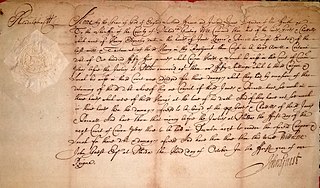Contempt of court, often referred to simply as "contempt", is the crime of being disobedient to or disrespectful toward a court of law and its officers in the form of behavior that opposes or defies the authority, justice, and dignity of the court. A similar attitude toward a legislative body is termed contempt of Parliament or contempt of Congress. The verb for "to commit contempt" is contemn and a person guilty of this is a contemnor or contemner.
In legal terminology, a complaint is any formal legal document that sets out the facts and legal reasons that the filing party or parties believes are sufficient to support a claim against the party or parties against whom the claim is brought that entitles the plaintiff(s) to a remedy. For example, the Federal Rules of Civil Procedure (FRCP) that govern civil litigation in United States courts provide that a civil action is commenced with the filing or service of a pleading called a complaint. Civil court rules in states that have incorporated the Federal Rules of Civil Procedure use the same term for the same pleading.

In court proceedings, a defendant is a person or object who is the party either accused of committing a crime in criminal prosecution or against whom some type of civil relief is being sought in a civil case.
A plaintiff is the party who initiates a lawsuit before a court. By doing so, the plaintiff seeks a legal remedy. If this search is successful, the court will issue judgment in favor of the plaintiff and make the appropriate court order. "Plaintiff" is the term used in civil cases in most English-speaking jurisdictions, the notable exceptions being England and Wales, where a plaintiff has, since the introduction of the Civil Procedure Rules in 1999, been known as a "claimant" and Scotland, where the party has always been known as the "pursuer". In criminal cases, the prosecutor brings the case against the defendant, but the key complaining party is often called the "complainant".
In law as practiced in countries that follow the English models, a pleading is a formal written statement of one party's claims or defenses in response to another party's complaint(s) in a civil action. The parties' pleadings in a case define the issues to be adjudicated in the action.
A statute of limitations, known in civil law systems as a prescriptive period, is a law passed by a legislative body to set the maximum time after an event within which legal proceedings may be initiated. In most jurisdictions, such periods exist for both criminal law and civil law such as contract law and property law, though often under different names and with varying details.
A lawsuit is a proceeding by one or more parties against one or more parties in a civil court of law. The archaic term "suit in law" is found in only a small number of laws still in effect today. The term "lawsuit" is used with respect to a civil action brought by a plaintiff who requests a legal remedy or equitable remedy from a court. The defendant is required to respond to the plaintiff's complaint or else risk default judgment. If the plaintiff is successful, judgment is entered in favor of the defendant. A variety of court orders may be issued in connection with or as part of the judgment to enforce a right, award damages or restitution, or impose a temporary or permanent injunction to prevent an act or compel an act. A declaratory judgment may be issued to prevent future legal disputes.
An arrest warrant is a warrant issued by a judge or magistrate on behalf of the state which authorizes the arrest and detention of an individual or the search and seizure of an individual's property.

In common law, a writ is a formal written order issued by a body with administrative or judicial jurisdiction; in modern usage, this body is generally a court. Warrants, prerogative writs, subpoenas, and certiorari are common types of writs, but many forms exist and have existed.
A subpoena or witness summons is a writ issued by a government agency, most often a court, to compel testimony by a witness or production of evidence under a penalty for failure. There are two common types of subpoenas:
- subpoena ad testificandum orders a person to testify before the ordering authority or face punishment. The subpoena can also request the testimony to be given by phone or in person.
- subpoena duces tecum orders a person or organization to bring physical evidence before the ordering authority or face punishment. This is often used for requests to mail copies of documents to requesting party or directly to court.
In the U.S. legal system, service of process is the procedure by which a party to a lawsuit gives an appropriate notice of initial legal action to another party, court, or administrative body in an effort to exercise jurisdiction over that person so as to force that person to respond to the proceeding before the court, body, or other tribunal.
Garnishment is a legal process for collecting a monetary judgment on behalf of a plaintiff from a defendant. Garnishment allows the plaintiff to take the money or property of the debtor from the person or institution that holds that property. A similar legal mechanism called execution allows the seizure of money or property held directly by the debtor.
In the common law legal systems, capias ad respondendum is or was a writ issued by a court to the sheriff of a particular county to bring the defendant, having failed to appear, to answer a civil action against him.
Default judgment is a binding judgment in favor of either party based on some failure to take action by the other party. Most often, it is a judgment in favor of a plaintiff when the defendant has not responded to a summons or has failed to appear before a court of law. The failure to take action is the default. The default judgment is the relief requested in the party's original petition.
Summary jurisdiction, in the widest sense of the phrase, in English law includes the power asserted by courts of record to deal brevi manu with contempts of court without the intervention of a jury. Probably the power was originally exercisable only when the fact was notorious, i.e. done in presence of the court. But it has long been exercised as to extra curial contempts.
A subpoena ad testificandum is a court summons to appear and give oral testimony for use at a hearing or trial. The use of a writ for purposes of compelling testimony originated in the ecclesiastical courts of Church during the High Middle Ages, especially in England. The use of the subpoena writ was gradually adopted over time by civil and criminal courts in England and the European continent.

The Wisconsin circuit courts are the general trial courts in the state of Wisconsin. There are currently 69 circuits in the state, divided into 10 judicial administrative districts. Circuit court judges hear and decide both civil and criminal cases. Each of the 249 circuit court judges are elected and serve six-year terms.
Pleading in England and Wales is covered by the Civil Procedure Rules (CPR). These rules set a high priority on attempts to resolve all matters able to be resolved by the parties, prior to hearing.
In law, an appearance occurs when a party to a lawsuit physically appears in court, or to a formal act through which a defendant submits to the jurisdiction of the court in which the lawsuit is pending.
Civil procedure in South Africa is the formal rules and standards that courts follow in that country when adjudicating civil suits. The legal realm is divided broadly into substantive and procedural law. Substantive law is that law which defines the contents of rights and obligations between legal subjects; procedural law regulates how those rights and obligations are enforced. These rules govern how a lawsuit or case may be commenced, and what kind of service of process is required, along with the types of pleadings or statements of case, motions or applications, and orders allowed in civil cases, the timing and manner of depositions and discovery or disclosure, the conduct of trials, the process for judgment, various available remedies, and how the courts and clerks are to function.



